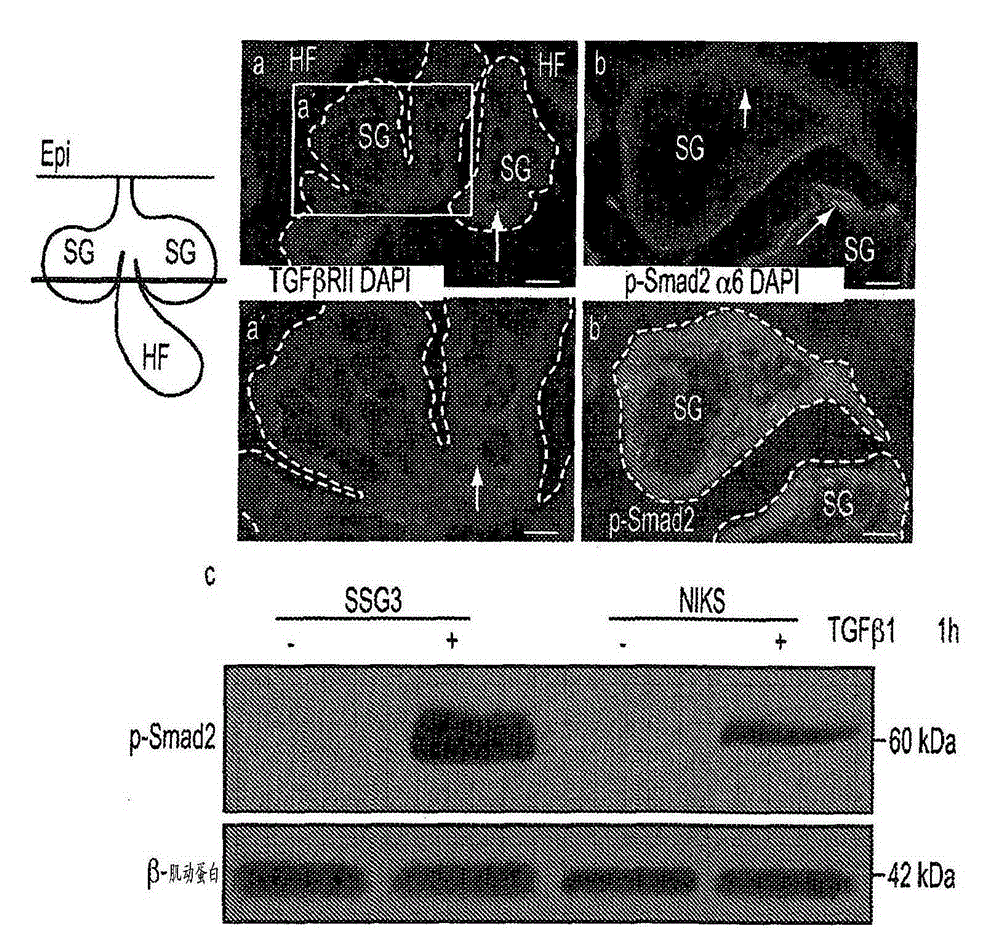Sebocyte cell culturing and methods of use
A sebocyte, cell-based technology for use in cell culture active agents, cell culture supports/coatings, botanical equipment and methods to address issues such as limiting the use of cell cycle and differentiation regulation
- Summary
- Abstract
- Description
- Claims
- Application Information
AI Technical Summary
Problems solved by technology
Method used
Image
Examples
Embodiment 1
[0048] [Example 1: Method for cultivating sebocytes]
[0049] Sebaceous gland clusters were generated from the scalp (SSG3), face and breasts of male and female donors aged 9 months to 12 years. Skin samples collected as surgical waste provided information on the age and sex of the donors with approval from the Institutional Board (IRB) of the Cincinnati Children's Hospital Medical Center.
[0050] After skin samples were cut into small pieces, samples were treated with 1X dispase (2 mg / ml in 1X PBS, Gibco / InvitrogenCat #17105-04; Carlsbad, California) overnight at 4°C prior to dissection. Dispase was used to separate the epidermis from the dermis and to avoid intermingling of epidermal cells.
[0051] After treating the skin with 1X dispase ( figure 1 ), using microsurgical instruments, the intact sebaceous glands were isolated under a dissecting microscope. The hair shaft and a small amount of tissue with sebaceous glands are preserved to preserve the microenvironment aro...
Embodiment 2
[0056] [Example 2: Characterization of cultured sebocytes]
[0057] 【method】
[0058] 【Western Blot】
[0059]Proteins were separated by electrophoresis on 10-12% acrylamide gels, transferred to nitrocellulose membranes and subjected to immunoblotting. Membranes were blocked for 1 h with 5% skim milk or 5% BSA in PBS containing 0.1% Tween-20. Typically the primary antibody is used at a concentration of 1 / 1,000 and the HRP-conjugated secondary antibody is used at 1 / 2,000 in 5% skim milk. Immunoblots were developed by using standard ECL (Amersham, Pittsburgh, PA) and Luminata™ crescendo and classico (Millipore). 2-color immunoblot detection was performed by using LI-COROdysseyCLx (LI-CORBiosciences, Lincoln, Nebraska). Membranes were blocked in Odyssey blocking buffer (LI-COR) and using secondary antibodies conjugated to IRDye680LT and 800CW (1 / 10,000; LI-COR). Protein levels were quantified by using an Odyssey infrared imaging system (LI-COR).
[0060] 【Retrovirus infectio...
Embodiment 3
[0113] [Example 3: Screening of Compounds]
[0114] Primary sebocytes are used to test compounds known to be inhibitors or activators of adipogenesis, and to identify compounds that test to inhibit or activate adipogenesis, or alter or alter the effect of an inhibitor or activator of adipogenesis.
[0115] Known inhibitors or activators of lipogenesis:
[0116] Androgens: sebum production under androgen control, and abnormal pilosebaceous unit response to androgens appear to be implicated in the pathogenesis of acne
[0117] 5α-reductase inhibitor (used in androgenetic alopecia): reduces lipogenesis
[0118] 5α-DHT (di-hydrotestosterone) (sebaceous gland-stimulating activity of androgens in vivo): increases proliferation, increases lipogenesis.
[0119] DHEA (5-dehydroepiandrosterone) (which is the main steroidal product secreted by the adrenal gland, acts on androgen receptors, androgenic effect on sebaceous gland activity): increases lipogenesis
[0120] Cyproterone aceta...
PUM
 Login to View More
Login to View More Abstract
Description
Claims
Application Information
 Login to View More
Login to View More - R&D
- Intellectual Property
- Life Sciences
- Materials
- Tech Scout
- Unparalleled Data Quality
- Higher Quality Content
- 60% Fewer Hallucinations
Browse by: Latest US Patents, China's latest patents, Technical Efficacy Thesaurus, Application Domain, Technology Topic, Popular Technical Reports.
© 2025 PatSnap. All rights reserved.Legal|Privacy policy|Modern Slavery Act Transparency Statement|Sitemap|About US| Contact US: help@patsnap.com



